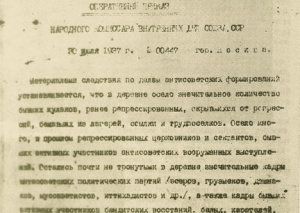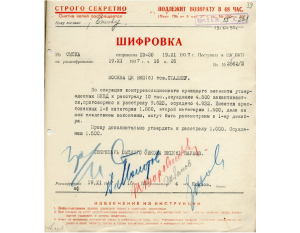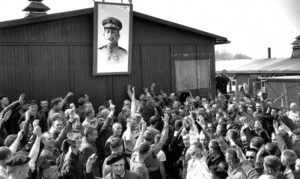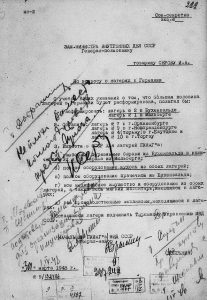Auschwitz: SOVIET VERSION
“Not a single socialist government that controls the whole life and industry of the country can afford to free, harsh, or angry expression of public dissent. They will have to resort to some form of the Gestapo - of course, with very humane goals at the initial stage.” Winston Churchill.
My goal for this blog is not to discuss political issues. My goal is to help men become better individuals. Better men, in my opinion, are those who, among other qualities, are politically educated, those who recognize the danger of socialism and teach their kids how to recognize it.
I wanted to provide you with some information to use in your conversations with kids, as well as an addendum to my concern about young men who lean towards socialism.
![]() Sixty kilometers from Krakow is the most terrible place in Europe - the death camp Auschwitz-Birkenau. In two years, the Nazis killed half a million people here.
Sixty kilometers from Krakow is the most terrible place in Europe - the death camp Auschwitz-Birkenau. In two years, the Nazis killed half a million people here.
This concentration camp in Poland, specially created for the secret mechanized extermination of people, became a symbol of all the most inhuman that happened in the twentieth century. Virtually the only symbol. In Western Europe, nothing worse did happen. But it did occur in the USSR.
 Seven or eight years before the release of Auschwitz by the Soviet soldiers, a series of special operations of the NKVD took place in the Soviet Union, later called the “Great Terror”.
Seven or eight years before the release of Auschwitz by the Soviet soldiers, a series of special operations of the NKVD took place in the Soviet Union, later called the “Great Terror”.
Its beginning dates back to July 30, 1937, when the Order of the NKVD No. 00447 was issued, setting quantitative "limits" for the first (shooting) and second (imprisonment) categories for each region of the USSR, and also established the personal composition of the "triplets" who were authorized to sentence (chief of the NKVD, Secretary of the regional committee, regional prosecutor).
The first page of Operational Order Number 00447 is dated July 30, 1937 (copy for the NKVD Administration of the Leningrad Region).
Within fifteen months, from August 1937 to November 1938, about two million people were arrested and convicted. Of those, 750 thousand were immediately shot. People are saying that there was a time when up to two thousand people were shot in Moscow per day. The scale is quite large. "Production tasks" were assumed to be almost the same as those in Auschwitz, as well as the organization, planning, and methods of work.
In 1937, most of the corpses were burned in the crematorium in the Donskoy Monastery. Then, when the crematoriums' performance was insufficient, they were buried in special zones.
Encrypted telegram from Omsk from 11.11.1937 “on the operation of the counterrevolutionary kulak element” (signatures: Stalin, Molotov, Voroshilov, Zhdanov, Yezhov).
![]() Fourteen years before the liberation of Auschwitz, in 1931, mass starvation was deliberately organized in Soviet villages. Not that the government wanted to kill as many people as possible, specifically, the goal was different.
Fourteen years before the liberation of Auschwitz, in 1931, mass starvation was deliberately organized in Soviet villages. Not that the government wanted to kill as many people as possible, specifically, the goal was different.
At this time, Western technologies for industrial and military facilities of the first 5-year plan were procured on a gigantic scale abroad. And the only source of foreign exchange was the sale of grain and wood abroad. Therefore, in the years 1931–1934, food in the villages was repossessed.
The exact number of victims of the “Holodomor” (mass starvation) is unknown. The numbers range from a minimum of three to four million to a maximum of eight to nine million people who have died of starvation. From two to six Auschwitz!
But the state industry for the extermination of people began to unwind even earlier when the Communist Party adopted the plans of the first 5-year plan, and the problem of providing construction for the workforce arose. The fact that people voluntarily left cities and villages to go to construction sites was out of the question.
Therefore, the plans for industrialization automatically included plans for repression—the planned use of forced labor on the all-Union scale.
From 1929 to the mid-1950s, about 15 million people passed through the Gulag on falsified political accusations. There were also deliberately brutal articles “for the plundering of socialist property” when people were planted for many years for the spicas of grain carried away from the field or a spool of thread from the factory (for example, the law of “seven eighths”, 7/8/1932 verdicts: from 10 years to execution).
Similarly, people were arrested for late work and absenteeism. In total, we can estimate that around 20 million people are affected. There were no death camps "per se" in the USSR, but the task of the authorities was purely pragmatic: in the shortest possible time to squeeze all the forces out of a person.
![]() By organization and technicality, the Soviet apparatus of repression was very similar to the Nazi’s apparatus. In scale, it far surpassed it.
By organization and technicality, the Soviet apparatus of repression was very similar to the Nazi’s apparatus. In scale, it far surpassed it.
Soviet prisoners raised a portrait of Joseph Stalin in honor of the release of Buchenwald. But they could not even imagine that many of them would be transferred directly from Buchenwald to the Gulag.
In the most difficult times, in the early 1940s, the average death rate in the camps as a whole reached 24% per year. It is difficult to count all those killed in the Gulag, but 1.5 - 2 million of Auschwitz is a pretty realistic estimate.
In addition to those arrested and passing through the camps, there were even more numerous groups of the repressed - victims of forced migrations, carried out from 1930 to 1952. This is about six million people. These are dispossessed peasants (kulaks), evicted from the cities, "deprived," and victims of ethnic deportations.
Ten nationalities were totally deported, and many were partially deported. Deportations were incredibly cruel and cold-blooded. Sometimes a whole train would be stranded in the winter savanna, where everyone would freeze to death in a couple of days (the case of the Russian Germans in Kazakhstan). Sometimes the population of entire villages was shot or burned alive if it was not possible to complete the deportation on time (Balkars). There are no exact death rates among the deportees, but this is approximately another Auschwitz.
The Red Army has liberated Auschwitz, but it guarded the Soviet camps to the last. Few people know that Nazi concentration camps have been used in this capacity for another five years! Among the most famous are Buchenwald and Sachsenhausen (Special Camp Number 2 and Special Camp Number 7, in Soviet terminology).
Since 1948, the special forces were reassigned to the Gulag, and in 1950, they were eliminated. But their equipment did not disappear: new zealous owners were taken out and used as intended in domestic camps. As indicated in this document, collapsible wooden huts, kitchen and laundry equipment, and medical supplies were exported to the USSR. In addition to some "production mechanisms," what is hidden under this ominous definition remains unclear in the document.
SOURCE: GA RF. F. 9414. OP. 1C. D. 360. L. 222
Therefore, there are no photographs of what was happening there, nor are there reliable figures or exhaustive documentation. The documentation, of course, is available, but only to FSB archivists. And they still do not share information. Therefore, today, only the Nazi concentration camps that have been well studied and turned into museums remain symbols of the mass destruction of people in the twentieth century.
The Soviet history after the Nazis should not become just history.
(Thank people like Dmitry Khmelnitsky who contributed to this article in the “Immortal Barrack” website.)
This is the face of real socialism, folks.
If you have missed the first article for the Social Life category, read it now.
If you like what you read and want to be notified about future articles, please subscribe for FREE (at the bottom of the page)




I just wanted to share with you some wise words from S. McDonald regarding Amazon, which has abandoned the plan to build its headquarters facility in New York. Why in this category? It is about socialist stupidity.
“Financial illiteracy in this country may have reached its pinnacle. The elected officials at the city and federal levels who opposed this gift from heaven, at least the ones whose quotes I have read, are money morons!
One New York City council member claimed that defeating this deal was a victory for the working guy. Huh?
The city lost 25,000 jobs, many of which were high-paying, white-collar positions. This deal would have required $3 billion in tax incentives, but it would have yielded $27.5 billion in tax revenue for the Big Apple and New York state over 25 years.
And few have counted the peripheral money and jobs that would have been generated from higher rents in that area of Long Island City, or the restaurants and ancillary services that would have been required to support 25,000 new positions there.
How about all the money that will be lost by the investors who renovated apartments in that section of New York? Or the money that has already been invested in food services and office supplies in the area?
The ideologues who sunk this deal are claiming a win against big business. Really? What about the little guys who would have benefited from it – the 25,000 folks who would have had great jobs, paid tons of taxes (local, state, and federal), and spent their money in the community?
Do these money morons who torpedoed the deal have any answers – or more importantly, jobs – for themselves?
What about the small investors who will lose everything they've invested in that area?
They’re crushing small investors and businesses.
Wake up! The most recent socialist disaster, Venezuela, didn’t happen because the logic “give away everything by taking it from businesses” doesn't work. It doesn’t work.
Everything we have – every dime in our pockets, every car, the loans that make buying them possible, every home, and every cent that makes our lives the best in the world – comes from an investor who put their money on the line for a business.
It is business that generates tax dollars and pays for everything we have. Yes, unfortunately, it also pays the salaries of those elected financial illiterates who cost New York 25,000 jobs.
And it gets worse. One of the elected officials affected by this stupidity stated that she wants to use the $3 billion incentive that Amazon would have received to repair the subway.
Unbelievable. Hello! She must be the leader of the money moron socialist stupidity club of that district. Those were tax breaks, not giveaways. Or how about this: the New York City Democratic Socialists of America said its members had been part of an “unprecedented mobilization” against this deal.
How about Rep. Alexandria Ocasio-Cortez and her followers, who were celebrating a great victory over big business? What has she offered besides more socialist stupidity?
Think about Venezuela, folks. If one of the wealthiest countries in South America, with the largest oil reserves in the world, can fall victim to this kind of financial stupidity, it can happen here. In a small way, it just did.
Please write to your elected representatives, both local and federal, and express your concerns about this issue.
Bravo, Amazon. And congratulations to whoever gets the 25,000 jobs.”